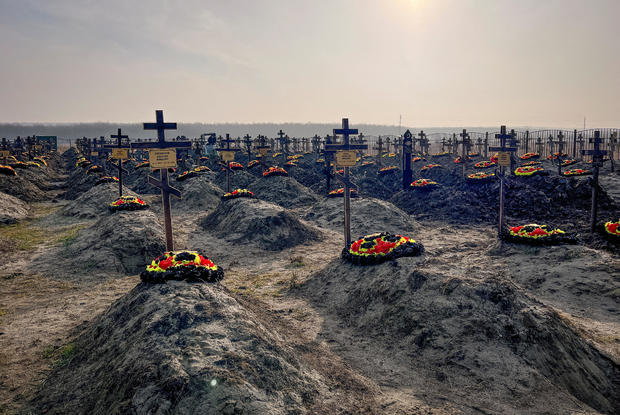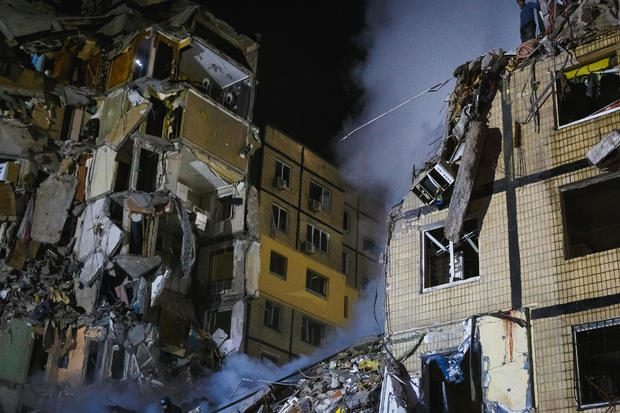One year of Russia’s war in Ukraine, by the numbers
One year after Russia launched its full-scale invasion of Ukraine, the conflict continues to take a terrible toll. Below is a look at some of the numbers that show the scale of the devastation, including the cost of the war in human lives, and the staggering financial commitment made by the U.S. and its partners to help Ukraine withstand the assault.
Military casualties
Neither Russia nor Ukraine has officially released casualty figures, but both countries are believed to have suffered huge losses on the battlefield since Vladimir Putin launched the invasion on Feb. 24, 2022.
Data compiled by Ukraine suggests Russia may have sustained some of its highest casualties of the entire war during the early months of 2023. Ukrainian forces on the front line have told CBS News that Russian commanders have thrown wave after wave of men at some battles as if they were meat.
STRINGER / REUTERS
Ukraine said an average of 824 Russian soldiers were dying every day in February 2023, and while those figures cannot be independently verified, the general analysis was supported by the U.K. government, which estimated this month that Russia has suffered between 175,000 and 200,000 casualties during its war in Ukraine, including 40,000 to 60,000 killed.
The British intelligence services estimated that Russia’s private Wagner Group, which has sent a large number of mercenaries, including convicts recruited from prisons, to the front lines in Ukraine, has taken losses at a rate of up to 50%.
For perspective, the then-Soviet Union lost a total of 15,000 troops during the entirety of its 10-year conflict in Afghanistan between 1979 and 1989.
In December, an adviser to Ukrainian President Volodymyr Zelenskyy said as many as 13,000 Ukrainian troops had been killed since the start of the war, CBS News partner network BBC News reported.
Ignacio Marin Fernandez/Anadolu Agency via Getty Images
United Nations data show that since the start of the war, more than 7,199 Ukrainian civilians have been killed and 11,756 have been injured, with most casualties caused by explosive weapons. The U.N. acknowledges that the real number of casualties is likely much higher, because information is difficult to obtain from areas where there’s heavy fighting.
War crimes
According to the European Union’s justice commissioner, 65,000 suspected war crimes have been reported since Russia launched its invasion of Ukraine.
There are a number of international treaties — the Geneva Convention and the Geneva Protocol being two of the most important — that establish international legal standards for warfare. Any violation of those standards is a war crime that can be prosecuted at the International Criminal Court in the Hague, and can result in imprisonment for perpetrators.
National governments, unilaterally or in partnerships, can also conduct their own war crimes investigations and prosecutions based on their own laws or the principle of universal jurisdiction, which determines some war crimes to be so extraordinary that they shock the conscience of humanity as a whole and therefore can be prosecuted anywhere.
Deliberate attacks against civilians are war crimes, as are “methods of war that are inherently indiscriminate and that simply can’t make the distinction between the civilian population and armed forces,” Jim Goldston, executive director of the Open Society Foundations’ Justice Initiative, told CBS News.
At least 6,000 Ukrainian children have been taken to camps and other facilities in Russia and Russian-occupied territory since the invasion began, prevented from communicating with their families and subjected to pro-Russian re-education, according to a recent report from the Conflict Observatory, a research group that monitors alleged Russian war crimes in Ukraine.
Refugees
More than 8 million Ukrainians have fled their country and become refugees across Europe since Russia’s invasion, according to U.N. data. More than 5.3 million others are still estimated to be internally displaced within Ukraine.
Yurii Stefanyak/Global Images Ukraine via Getty Images
According to interviews conducted with over 43,000 Ukrainian refugees, the vast majority of people who’ve fled the country have been separated from family members, most often due to Ukraine’s restrictions on men of fighting age leaving the country under its system of martial law, which was declared after Russia’s invasion.
The largest group of refugees are women between the ages of 18 and 59, followed by children between the ages of 5 and 17.
International aid
The United States was long the single largest national provider of aid to Ukraine. From Jan. 24, 2022 through February 2023, the U.S. government says it had committed more than $29.8 billion in military aid alone.
According to the Kiel Institute for the World Economy, a German think tank, the U.S. had also committed some $16 billion in financial aid and $10.5 billion in humanitarian aid.
Late last year, the European Union’s combined contributions exceeded U.S. support, according to the Kiel Institute.
–Melania Hidalgo contributed to this report
For all the latest World News Click Here
For the latest news and updates, follow us on Google News.




